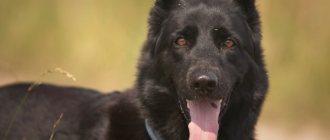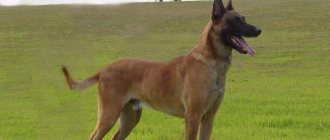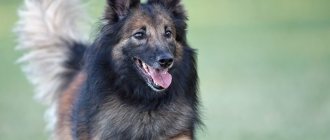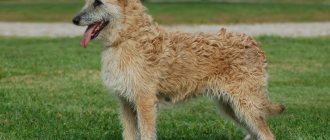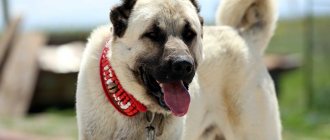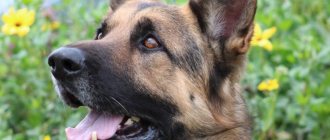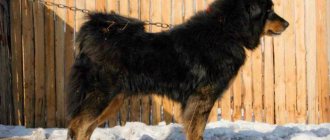Malinois photo
| Origin | Belgium |
| Usage | Security guards; shepherds |
| Color | Shades of red color; on the face the mask is a darker shade than the main color. |
| Dimensions | Height (cm) 56-65; male Malinois weight (in kg) 27-30, females from 20 to 26 kg. |
| Lifespan | up to 14 years old. |
In search of a reliable and faithful friend, you should look at the Belgian Shepherd and become familiar with the subtleties of character and behavior. Belgian Shepherds are divided into four subspecies: Malinois, Tervuren, Groenendael, Laekenois. Separately, the Malinois is noted as an example of fidelity and grace. The ability to learn allows it to be used in such areas as rescue and search work, service in law enforcement agencies.
Breed standard
The Belgian Malinois is a harmoniously developed animal with a proportional build. The original breed standard, dated 1892, was set uniformly for all Belgian Shepherds: one species, varying in coat type. It was only in 1907 that a decision was made to divide the Belgians into 4 subspecies, differing in coat type and color: Malinois (short-haired); Laekenois (wire-haired); Groenendael and Tervuren (long-haired).
The table below describes the Malinois breed standards.
| Options | Description |
| Head | Elongated shape. The length of the muzzle is equal to the length of the head. |
| Frame | Powerful yet lightweight. The height at the withers is equal to the length of the body. |
| Muzzle | Elongated wedge-shaped. The nose is black, the nostrils are wide. |
| Ears | Triangular ears with strong cartilage, point straight up. |
| Neck | Muscular, elongated, widening towards the shoulders. |
| Eyes | Almond-shaped eyes, non-protruding, from light brown to dark chocolate color. |
| Bite | Scissor-shaped or pincer-shaped. |
| Malinois colors | Red coat color all over the body with a dark mask on the muzzle. Dark overlay - each hair at the tip is colored black, spread throughout the body. |
| Wool | Short, dense, harsh with medium undercoat. |
| Tail | Thick at the base, tapering towards the tip. Saber-shaped, not rising above the level of the body. |
| Limbs | The forelimbs are powerful, with well-developed bones. Not twisted. The hind limbs are muscular and strong. |
| Paws | The fingers are gathered into a ball, the claws are dark and hard. |
| Movements | The movements are active, more running in a circle than in a straight line. All limbs move at the same level, without standing out. |
Signs according to which rejection occurs:
- Increased aggression or cowardice.
- Undershot or overshot.
- Drop ears.
- Tail docked at birth or during life.
- Curling tail.
- No mask on the face.
- White spots on the body.
Each dog has a unique mask, which can be seen in the photo of the Malinois shepherd dog.
National pride of Belgium
Until recently, there was controversy surrounding the origin of the Malinois breed: some dog experts believed that this breed was French, and some insisted that these dogs were bred in Belgium. The origin has become a matter of dispute due to the French spelling of the city of Malines (Mechelen - Dutch, Mecheln - Flemish, Malines - French) in the province of Antwerp. Dutch at that time was not yet used as an official language, and documents were filled out in French. Like any selective breed, a professional was behind the breeding of the Belgian Shepherd - veterinarian Adolf Riyul . Professor Riyul set himself the goal of showing the world a special breed, the national pride of Belgium - a dog with special characteristics. The choice for selection fell on herding dogs, which for decades served local residents and guarded their homes. In the process of breeding “national pride,” the breeder relied on the quality of the coat, selecting medium-sized dogs, but different in color and coat length. In 1892, the professor presented the Belgian Shepherd at an exhibition. 15 years later, cynologists, based on the species bred by Riyul, established three new standards for this breed with different colors and coat lengths: the Groenendael - semi-long-haired with black color, the Laekenois - gray-ash color with long hair, and, in fact, the Malinois - a dog endowed with short hair and dark brown or charcoal color.
Character
The Malinois has a balanced character. He is vigilant, not timid, and has innate protective qualities. Obedience and affection make him a loyal friend and companion. A lively and active dog needs an equally energetic owner. Without physical exercise, the Malinois can become aggressive, because the historical purpose of the shepherd requires a burst of energy. With proper upbringing, he becomes a full member of the family, a friend for children.
The Belgian Malinois is able to accurately recognize a person’s mood and the atmosphere in the house.
Will not tolerate rude treatment, indifference is a real punishment for the Belgian. Does not strive to be the dominant one in the family; he considers the owner to be the center of the Universe. The main characteristic of the breed is determination and efficiency.
Advantages
- Genetically, Belgian Shepherds were bred to guard sheep and other livestock. Therefore, the most important quality for them is observation. These dogs take their work very seriously, are helpful and devoted to their owner, and follow all his orders.
- Malinois are highly intelligent. They understand at a glance, thanks to this they are amenable to training and education. Quite patient, but cannot stand rudeness.
- These dogs have huge hearts. They will become a loyal friend and family member, accompany you on a hike, a trip, and will be a good running partner. The attitude towards children is ambiguous, rather positive, but dog experts do not advise leaving such serious large pets alone with babies.
- Hardy . They tolerate both heat and cold and do not need a lot of drinking or feeding. Developed sense organs allow one to notice danger from afar.
- Positive qualities allow the “Belgians” to work in many law enforcement agencies: the Ministry of Emergency Situations, the police, military organizations, customs garrisons. Dog handlers believe that the Malinois is more suitable for service than the German Shepherd. She needs food and sleep less, is not so spoiled and is more resilient.
Application
The Belgian Malinois is a hardy, strong animal. Adapted to various weather conditions, it is not afraid of rain, heat or cold.
The Malinois is considered the most adapted to harsh conditions compared to other Belgians. After all, dogs were originally bred to help herd and guard livestock. Over time, these qualities improved, and the most productive individuals were selected for further breeding. Such qualities as resistance to stress, sociability, and gentleness were valued.
Modern Belgian Malinois dogs are divided into two groups: working dogs and ring participants. Working dogs are used in the service of law enforcement agencies. Their help in searching for missing people, in police service, and security is invaluable. Ring dogs are also hard workers, but in a different direction. Participation in sports competitions and exhibition shows fully demonstrates the dog’s capabilities.
Appearance
The Malinois is not the largest and fastest line of the "Belgians", this place is occupied by Tervuren, but this does not at all reduce the working value of the dog. Not too large, lean, flexible, muscular shepherd dog can give odds to many in any ring and test. Medium dimensions make the Malinois more resilient. The dog is proud and graceful when viewed, but can turn into a fearless beast if the owner is in danger. Belgian Shepherds are medium in size. Depending on gender, height and weight are:
- Male: 60–66 cm; 26–30 kg.
- Female: 56–64 cm; 20–26 kg.
Socialization
Socialization is the level of a dog’s comfortable state of health in a particular setting or situation. If a Malinois dog lives in an urban environment, then such qualities as not being afraid of city noise, transport, lack of aggression towards large numbers of people, and an indifferent attitude towards stray dogs and cats are instilled.
The dog requires early socialization to develop its character, otherwise it will grow up suspicious and aggressive.
Animals in rural areas need to be socialized more than their urban counterparts. Especially if the dog is planned to be exhibited in the future. A Malinois sitting behind a fence, not seeing anyone except members of the household, will not be able to behave adequately in the ring if it finds itself in an unfamiliar environment.
The first activities are carried out after scheduled vaccinations. They begin to take the puppy to quiet places. Each time they increase the walking area, introducing them to new surroundings. Once the puppy has established contact with its owner, you can move on to the next stage—meeting other dogs and people.
Training
As soon as the puppy appears in the house, the owner must establish proper contact with him. A positive outcome of training is ensured precisely from this period, since respect for the owner is the main thing that will guide his behavior in the future.
The correct response to basic commands will be the result of regular physical exercise and training only if the dog respects the owner. To do this, true friendship and respect must begin between them from the first contacts. Playing together, a moderately strict attitude, fair distribution of responsibilities, well-deserved praise are the principles of education that result in an obedient and competent animal.
How to choose a puppy
When choosing a puppy for an exhibition, you should prefer those nurseries that can boast of achievements in exhibition activities. Future ring champions and participants in various show programs are bred here.
A decent breeder is always ready to make contact with the future owner of the puppy, will tell you everything about the Malinois breed, and give advice on care and maintenance. The main condition is that the puppy, like his mother, must look healthy: moderately well-fed, eyes, nose and ears free of purulent discharge. The coat should cover the entire body evenly, without bald spots. A healthy puppy has a good appetite, so it’s worth trying (with the breeder’s permission) to feed him.
The baby goes to a new home at the age of 8-9 weeks. At this point, the first series of scheduled vaccinations has already been done, and the puppy has begun to try “adult” food. To prevent the Malinois puppy from being sad, you need to take with you something with the smell of its mother: a bedding or some other rag. This makes it easier for him to cope with the stress of moving.
It is not recommended to buy a puppy secondhand at bird markets or through private advertisements. No one will give any guarantees regarding breed and health status.
Features of maintenance and care
Shepherds are working dogs. It is better to keep them in a private house with a spacious yard or area where the dog can run freely. They adapt well to living in city apartments. In this case, the owner must devote more time to walking the pet. The peculiarity of the breed is that a Malinois sitting idle for too long can become irritable and aggressive.
Grooming
Grooming procedures can be carried out at home, which significantly saves the family budget.
- Grooming
The Malinois' coat is easy to care for - comb out during shedding with a fine-toothed comb, and periodically wipe the surface of the entire body with a damp cloth. These manipulations are enough.
- Nail care
Trim as it grows. Usually once every 2-3 weeks.
- Ear care
Once a week, wipe the inside surface from dust and dirt. During the period of tick activity, inspection for their presence is necessary. A dog that spends most of its time outside is examined daily. To treat an animal against parasites, sprays are used that repel ticks and other blood-sucking insects.
Bathing
The dog was bred to live outside, so it does not need frequent bathing. It is enough to wash once every 3 months. Its fur has dirt-repellent properties. Of course, when you come back from a walk in rainy weather, you wash your paws. The animal is accustomed to this procedure from early childhood. In summer, swimming in open water is recommended; there are no restrictions. Malinois usually love to swim in the river or sea.
Walk
In order not to lose physical shape, the animal needs long walks and significant physical activity. The Malinois needs this vitally. Loves ball games, frisbee (games with a flying disc), agility (overcoming various obstacles). Any active actions delight the Belgian. You won't find a better companion for long hikes.
Feeding
Proper nutrition from an early age will allow you to raise a healthy and harmoniously developed dog. The Malinois needs a balanced diet that will satisfy the animal's need for all nutrients. Overfeeding, as well as underfeeding, may in the future result in problems with metabolism and the functioning of the reproductive system.
An adult dog is fed twice a day. Products included in the Malinois' natural diet:
- Meat.
- Roots.
- Cereals.
- Fermented milk products.
- Fish.
With a natural diet, you need to periodically provide a multivitamin supplement.
The drinking regime is calculated based on the dog's needs. An adult dog has 40 grams of water per 1 kg of animal weight. Young animals need 80-90 grams of fluid per 1 kg of weight.
Eating industrial food (dry, canned) gives confidence that the pet is fully provided with all the vitamins and nutrients that fully satisfy the dog’s needs. The value of ready-made dry food is that it is easily selected according to the dog’s age, and also corrects emerging diseases.
Classification of dry food:
- For puppies.
- For adult animals.
- For nursing bitches.
- For older dogs.
- Hypoallergenic food.
- Diet for sterilized dogs.
- Food that improves digestion.
Interaction with other animals
This breed of dog amazingly combines protective qualities and hunting instinct. Malinois perceive small pets as potential prey and can actually hunt them. It’s easy to guess that a cat, rabbit or toy dog is unlikely to survive a fight with such a strong opponent as the Belgian Shepherd.
Malinois will also not get along with large dogs. Belgian Shepherds are jealous of their own territory, and they do not agree to share the attention of their beloved owner with other animals. The other dog is a rival in the eyes of the Belgian, and he will make every effort to defeat the enemy. And although Malinois are not characterized by anger and aggression, in most cases they will be the ones who initiate a fight, simply in order to demonstrate to the owner their indispensability and superiority.
Malinois do not get along well with any pets
Therefore, it is not recommended to have other pets in a house where the Belgian feels like a full owner.
A loyal attitude of shepherd dogs towards other animals is only possible if they are raised together from a young age.
There will be no friendship between the pets, but they will live quite peacefully on the same territory, where each will establish clear boundaries of their possessions.
Health
The Belgian Malinois is considered one of the healthiest breeds: it is suitable for outdoor living and is not susceptible to colds. With proper care, a dog can live up to 14-15 years, while maintaining its working qualities for up to 10-12 years.
Diseases
Common diseases include food allergies. Also, due to improper nutrition and lack of exercise, the dog may become obese.
Vaccinations
Routine vaccinations are required for Malinois just like all dogs. No animal is immune from such life-threatening diseases as plague and rabies. Vaccinations performed strictly according to an individual schedule will reduce the risk of disease.
The first standard manipulations are carried out at 2 months of age. The puppy is first treated for fleas and worms: the presence of parasites can negate the effectiveness of vaccinations. In the table below you can see the planned immunization activities.
| Disease | Vaccination procedure | Revaccination | Next vaccination |
| Rabies | 12-13 weeks | At 12 months | Annually |
| Hepatitis | The first vaccination is at 8-10 weeks, the second after 3-4 weeks. | At 12 months | Annually |
| Plague | The first vaccination is at 8-10 weeks, the second after 3-4 weeks. | At 12 months | Annually |
| Parvovirus | The first vaccination is at 8-10 weeks, the second after 3-4 weeks. | At 12 months | Annually |
| Microsporia | 1-6 months | In 2 weeks | Annually |
Breed diseases
In general, experts note that Belgian Shepherds have excellent health. The lifespan of a Malinois is 12-15 years.
However, representatives of this breed may also develop some diseases, including those of a genetic nature:
- eye problems - atrophic changes in the retina, cataracts, in advanced cases can lead to blindness of the animal; early diagnosis and proper treatment are required;
- dysplasia of large joints; such a violation negatively affects the formation of joint tissue; the disease has a protracted development, therefore it is most often detected in an advanced stage; in most cases requires surgical intervention;
- hormonal imbalance – a malfunction of the thyroid gland can cause a number of diseases, ranging from depression to diabetes;
- Gastric volvulus is a pathology that is impossible to predict and is accompanied by pain and swelling of the peritoneum; with oxygen deficiency, damage and death of stomach cells occurs; surgical assistance is required;
- epilepsy.
Due to excessive activity and mobility, Malinois are often injured. These dogs never give in to difficulties, they “take” new records, which is why they develop damage to their paws and muscles.
Mating
The best age for the first mating of both a female and a male is 1.5-2 years. To find a suitable partner, contact the nursery. There you can choose the best copy. The dogs are walked before the meeting; there is no need to feed them. The “bride” arrives at the “groom’s” territory. Malinois usually knit on their own and do not need human help. To consolidate the result, it is recommended to repeat mating after 1-2 days.
Matings between different types of Belgian Shepherds are prohibited.
Flaws
- The breed has few disadvantages . They absolutely cannot stand loneliness and need constant attention and care. In such conditions, the dog withers, loses activity and adequacy.
- Likewise, Malinois do not like enclosed spaces and require constant active walking . They need strict upbringing and daily training to properly develop their skeleton and character. Hyperactive, mischievous, love to dig and chew. They are unkind to other pets, especially relatives.
- They shed actively in autumn and spring . When kept in apartments, they shed all year round and must be brushed daily.
- Without proper upbringing, they become aggressive and disobedient. Absolutely not suitable for beginners.
How much do Malinois puppies cost?
To purchase a puppy with a good pedigree, you should contact a nursery. The price for working dog puppies will range from 35 to 50 thousand rubles. For puppies intended for show shows, the price can reach 60 thousand rubles.
Sometimes puppies appear in nurseries with traces of defects, due to which the dog cannot participate in exhibitions and breeding in the future. Such puppies are given away almost for nothing. If you need a dog to guard your home, or just as a friend, without plans for a show future, then you can take it without a pedigree.
Nurseries
Malinois (Belgian Shepherd) is the most popular dog for service in the police and army, in disaster medicine units. Thanks to its high sense of smell, it is the best assistant in searching for people and detecting narcotic and illegal substances. A dog whose life without work is impossible. Malinois puppies purchased from professional nurseries have every chance of becoming ring champions.
Vyatkina nursery https://working-malinois.com/
Service dog nursery https://www.freiwind.ru/index.html
Faithful, selflessly devoted, ready to come to the rescue at any moment, and at the same time affectionate dog - the most suitable description of the Malinois breed. This is an ideal companion dog for sporty and socially-loving people.
Price
A Belgian Shepherd costs an average of $200 to $1000 . The price depends on the breed class, color, level of the nursery, documents and the presence of working genes. A puppy of the simplest class is suitable for the home. If it is important for the owners that the pet takes part in exhibitions, they need to purchase a show-class breed.
The price for dogs of this breed from private individuals will be lower than from the breeder. There are nurseries both in Russia and abroad.
In order not to make a mistake when choosing a puppy, you should carefully choose the seller. Before buying a Belgian Malinois, it is advisable to read reviews from previous owners, characteristics of the breed and find out how much a particular puppy will cost. It is best to visit the nursery in person rather than choosing a pet based on a photo.
AMERICAN TOY FOX TERRIER: HISTORY OF THE BREED AND CHARACTER OF THE DOG
ENGLISH SPRINGER SPANIEL: BREED CHARACTERISTICS AND HISTORY OF ORIGIN
AMERICAN AKITA: ORIGIN AND CHARACTER OF THE DOG
MONGOLIAN SHEPHERD BANKHAR: ORIGIN AND CHARACTER OF THE DOG
Interesting stories
In 2022, which is considered the year of the dog according to the Chinese calendar, a short film “A New Year's Story Told by a Malinois” was prepared. The main role is given to this wonderful dog, and the story is told from her perspective. The film was created with the participation of the Russian National Guard film studio.
photo of dog
Another example from the film career of four-legged Belgians. In 2015, the film “Max” was released, telling about the difficult fate of the Malinois. While serving in Afghanistan, he loses his friend and partner Kyle. After suffering stress, the dog cannot perform combat missions, and the military believes that the animal must be euthanized. But Kyle's family decides to take Max for themselves. This film is about how Max learns to exist in a world without bombings and shootings, about friendship and loyalty.
Attitude towards children
For a teenager, the Belgian Malinois will be an excellent partner in fun and active games. No matter what kind of sport a child is into, a dog will always be happy to keep him company.
But with small children it’s not so simple. If you give your dog instructions to look after your child, you can be sure that your responsible pet will do an excellent job. The Belgian will not take his eyes off the baby, will make sure that he does not leave the yard and will not let strangers near him.
The Belgian Shepherd will guard and protect the child, but will not tolerate disrespectful treatment.
But with these actions, the pet will consider its duty towards the child fulfilled. After all, a Malinois will not make a caring and patient nanny who allows herself to be pulled by the tail or squeezed her neck in a tight hug. The Belgian Shepherd demands respectful and respectful treatment and will not tolerate the baby treating it as its own toy.
Of course, a well-bred pet will never bite a baby or harm him. If the child bothers the dog, the Belgian will simply hide from him in a secluded place, while not forgetting to watch him in order to protect him in case of danger. But still, you should not leave small children alone with a shepherd dog, and it is advisable that one of the adults supervise the interaction between the animal and the child.
